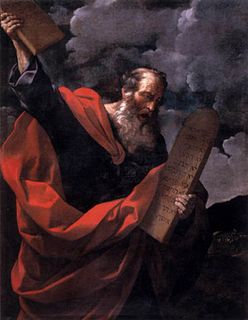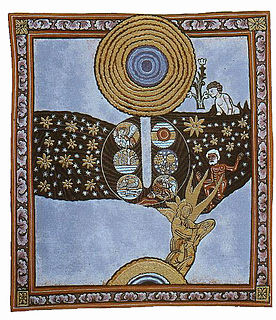
The Book of Exodus is the second book of the Bible. It narrates the story of the Exodus,in which the Israelites leave slavery in Biblical Egypt through the strength of Yahweh,who has chosen them as his people. The Israelites then journey with the prophet Moses to Mount Sinai,where Yahweh gives the 10 commandments and they enter into a covenant with Yahweh,who promises to make them a "holy nation,and a kingdom of priests" on condition of their faithfulness. He gives them their laws and instructions to build the Tabernacle,the means by which he will come from heaven and dwell with them and lead them in a holy war to possess the land of Canaan,which had earlier,according to the story of Genesis,been promised to the seed of Abraham.

The Book of Genesis is the first book of the Hebrew Bible and the Christian Old Testament. Its Hebrew name is the same as its first word,Bereshit. Genesis is an account of the creation of the world,the early history of humanity,and of Israel's ancestors and the origins of the Jewish people.

Japheth is one of the three sons of Noah in the Book of Genesis,in which he plays a role in the story of Noah's drunkenness and the curse of Ham,and subsequently in the Table of Nations as the ancestor of the peoples of the Aegean Sea,Anatolia,and elsewhere. In medieval and early modern European tradition he was considered to be the progenitor of the European peoples,while Islamic traditions also include the Chinese people among his descendants.

Moses is considered the most important prophet in Judaism and one of the most important prophets in Christianity,Islam,the Druze faith,the BaháʼíFaith and other Abrahamic religions. According to both the Bible and the Quran,Moses was the leader of the Israelites and lawgiver to whom the authorship,or "acquisition from heaven",of the Torah is attributed.

The Torah is the compilation of the first five books of the Hebrew Bible,namely the books of Genesis,Exodus,Leviticus,Numbers and Deuteronomy. In that sense,Torah means the same as Pentateuch or the Five Books of Moses. It is also known in the Jewish tradition as the Written Torah. If meant for liturgic purposes,it takes the form of a Torah scroll. If in bound book form,it is called Chumash,and is usually printed with the rabbinic commentaries.

The documentary hypothesis (DH) is one of the models used by biblical scholars to explain the origins and composition of the Torah. A version of the documentary hypothesis,frequently identified with the German scholar Julius Wellhausen,was almost universally accepted for most of the 20th century. It posited that the Pentateuch is a compilation of four originally independent documents:the Jahwist (J),Elohist (E),Deuteronomist (D),and Priestly (P) sources. The first of these,J,was dated to the Solomonic period. E was dated somewhat later,in the 9th century BCE,and D was dated just before the reign of King Josiah,in the 7th or 8th century. Finally,P was generally dated to the time of Ezra in the 5th century BCE. The sources would have been joined together at various points in time by a series of editors or "redactors."

The Samaritan Torah,also called the Samaritan Pentateuch,is a text of the Torah written in the Samaritan script and used as sacred scripture by the Samaritans. It dates back to one of the ancient versions of the Hebrew Bible that existed during the Second Temple period,and constitutes the entire biblical canon in Samaritanism.

The historicity of the Bible is the question of the Bible's relationship to history—covering not just the Bible's acceptability as history but also the ability to understand the literary forms of biblical narrative. One can extend biblical historicity to the evaluation of whether or not the Christian New Testament is an accurate record of the historical Jesus and of the Apostolic Age. This tends to vary depending upon the opinion of the scholar.

Philo of Alexandria,also called Philo Judaeus,was a Hellenistic Jewish philosopher who lived in Alexandria,in the Roman province of Egypt.

The Law of Moses,also called the Mosaic Law,primarily refers to the Torah or the first five books of the Hebrew Bible. They were traditionally believed to have been written by Moses,but most academics now believe they had many authors.

The genealogies of Genesis provide the framework around which the Book of Genesis is structured. Beginning with Adam,genealogical material in Genesis 4,5,10,11,22,25,29–30,35–36,and 46 moves the narrative forward from the creation to the beginnings of the Israelites' existence as a people.

According to the documentary hypothesis,the Elohist is one of four source documents underlying the Torah,together with the Jahwist,the Deuteronomist and the Priestly source. The Elohist is so named because of its pervasive use of the word Elohim to refer to the Israelite god.

The Jahwist,or Yahwist,often abbreviated J,is one of the most widely recognized sources of the Pentateuch (Torah),together with the Deuteronomist,the Priestly source and the Elohist. The existence of the Jahwist is somewhat controversial,with a number of scholars,especially in Europe,denying that it ever existed as a coherent independent document. Nevertheless,many scholars do assume its existence. The Jahwist is so named because of its characteristic use of the term Yahweh for God.

The Priestly source is a theory of the origins of the Bible,perhaps the most widely recognized source underlying the Torah. It is both stylistically and theologically distinct from other material in the Torah,and includes a set of claims that are contradicted by non-Priestly passages and therefore uniquely characteristic:no sacrifice before the institution is ordained by Yahweh (God) at Sinai,the exalted status of Aaron and the priesthood,and the use of the divine title El Shaddai before God reveals his name to Moses,to name a few. In general,the Priestly work is concerned with priestly matters –ritual law,the origins of shrines and rituals,and genealogies –all expressed in a formal,repetitive style. It stresses the rules and rituals of worship,and the crucial role of priests,expanding considerably on the role given to Aaron.

The Exodus is the founding myth of the Israelites whose narrative is spread over four books of the Torah or Pentateuch,namely Exodus,Leviticus,Numbers,and Deuteronomy. The majority of modern scholars date the composition of the Torah to the Middle Persian Period. Some of the traditions contributing to this narrative are older,since allusions to the story are made by 8th-century BCE prophets such as Amos and Hosea.

Mosaic authorship is a traditional Judeo-Christian belief that the Torah,the first five books of the Hebrew Bible/Old Testament,were written primarily by Moses. Some rabbinical traditions posit that the contents of the Torah were dictated to Moses by God on Mount Sinai. The books do not name any author,as authorship was not considered important by the society that produced them,and it was only after Jews came into intense contact with author-centric Hellenistic culture in the late Second Temple period that the rabbis began to find authors for their scriptures. The tradition that Moses was this author probably began with the legalistic code of the Book of Deuteronomy and was then gradually extended until Moses,as the central character,came to be regarded not just as the mediator of law but as author of both laws and narrative.
The earliest known precursor to Hebrew,an inscription in the Paleo-Hebrew alphabet,is the Khirbet Qeiyafa Inscription,if it can be considered Hebrew at that early a stage.

The primeval history is the name given by biblical scholars to the first eleven chapters of the Book of Genesis,the story of the first years of the world's existence.

The composition of the Torah was a process that involved multiple authors over an extended period of time. While Jewish tradition holds that all five books were originally written by Moses sometime in the 2nd millennium BCE,leading scholars have rejected Mosaic authorship since the 17th century.

Since early modern times,a number of biblical ethnonyms from the Table of Nations in Genesis 10 have been used as a basis for classifying human racial and national identities. The connection between Genesis 10 and contemporary ethnic groups began during classical antiquity,when authors such as Josephus,Hippolytus and Jerome analyzed the biblical list.














